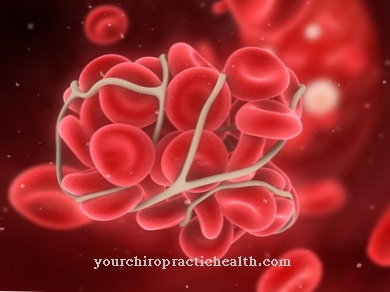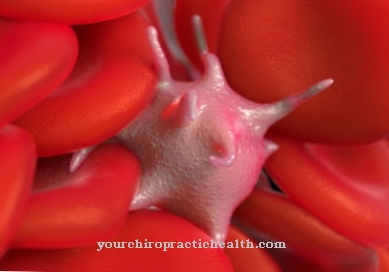As Blastogenesis the 16 days early development of the fertilized female egg, the zygote, to the blastocyst is called. During blastogenesis, the cells that were still omnipotent at the time divide and, towards the end of the phase, undergo an initial differentiation into an outer shell of cells (trophoblast) and cells inside (embryoblast), from which the embryo develops.
What is blastogenesis?

Blastogenesis comprises the earliest development stage of the fertilized female egg, the zygote, up to the blastocyst. The total period of blastogenesis is 16 days from the time of fertilization to the blastula stage.
The fertilized egg goes through several stages during blastogenesis. About 40 hours after fertilization, the four-cell stage is reached after two mitotic divisions and the 16-cell stage after 3 days. In this phase, the small cluster of cells is enveloped by a firm skin, the zona pellucida. The skin is so firm that the small cluster of cells initially retains its initial volume. From the 16- or 32-cell stage, the small collection of cells is known as blastomeres. The term morula is also common, as the small "pile of cells" is reminiscent of a cluster of mulberries.
During blastogenesis, the zygote slowly migrates from the fallopian tube into the uterus, transforming it. Towards the end of blastogenesis, the blastomere reaches the blastocyst stage. An initial differentiation of the previously omnipotent cells into an outer shell of cells (trophoblast) and the cells inside (embryoblast) has already taken place. While the outer cells take on the function of implantation in the uterine lining, the inner cells serve exclusively for embryonic development.
Blastogenesis is followed by embryogenesis, which can be divided into several phases.
Function & task
The main purpose of blastogenesis is to protect the fertilized egg in order to ensure undisturbed and almost self-sufficient development until it is implanted in the uterus. The zona pellucida, which hardens immediately after the penetration of a sperm, primarily prevents the penetration of a second sperm (polyspermia), which in most cases would lead to a break in development. Another task of the zona pellucida is that the fertilized egg cannot establish itself in the fallopian tube, which would result in a dangerous ectopic pregnancy, with the necessity of an abortion. The solid membrane also holds the developing cells together, which are still omnipotent in this phase and cannot be distinguished from one another. You will also be saved from a possible immune attack.
Since the female egg has enough reserves to be largely self-sufficient in terms of metabolism and energy supply during blastogenesis, there is also good protection against infections or problematic substances that could be transmitted from the mother during the first five days.
The morula has now left the fallopian tube and is in the uterus.The original protective functions of the zona pellucida are no longer necessary, so that the blastocyst, with the support of enzymatic processes, ruptures the egg envelope and slips out of the envelope (hatching). The most important task of the trophoblast is now the nidation, the complex process of implantation of the blastocyst in the epithelium of the uterine mucosa, with the aim of an early connection to the blood supply.
During the first phase of blastogenesis, the cells are omnipotent and theoretically they can differentiate into any tissue cell. This has the advantage that in the event of division problems they can take over the function of any other cell, so that errors in division are usually corrected themselves. Towards the end of blastogenesis, the embryoblast develops into a two-leaved cotyledon. This means that the cells of the two cotyledons gradually lose their omnipotence, a development that continues during subsequent embryogenesis.
Illnesses & ailments
During the first phase of blastogenesis, before nidation, the blastomere is relatively protected from external toxic or hormonal influences. In this almost self-sufficient phase, problems that arise, which are summarized under the term blastopathy, are mostly due to errors in the numerous mitoses that take place. At this stage of development, the “all or nothing” principle applies. Either the blastomeres can repair the defect themselves or the blastomeres die off with subsequent rejection.
However, in very rare cases, with incomplete separation of the cells, symmetrical double malformations can develop after mitosis, which are neither repaired nor lead to rejection reactions. The system for Siamese twins can develop from this.
By far the most common problem during blastogenesis is an extrauterine or ectopic pregnancy, which in most cases develops in the fallopian tube as an ectopic pregnancy. If the migration of the blastomeres from the fallopian tube into the uterus is delayed, it can become lodged in the fallopian tube and cause an ectopic pregnancy to begin. There are many reasons that can prevent the fertilized egg from getting into the uterus. For example, the function of the ciliated epithelium of the fallopian tubes may be impaired by bacterial infections or there may be genetically determined malformations. Usually, an ectopic pregnancy leads to rejection reactions that cause the blastomeres to die and lead to an abortion. In many cases the process goes almost unnoticed.




.jpg)



















.jpg)



